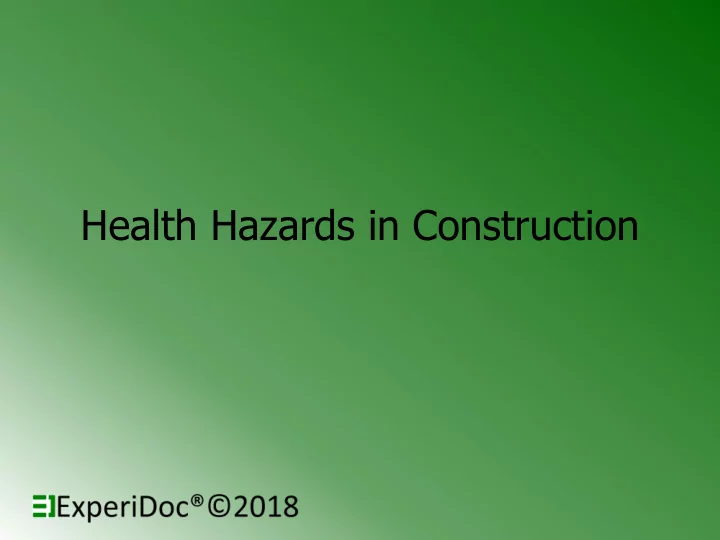

Health Hazards in Construction
Health Hazards Potential exposures to health hazards: • Worker on the job • Worker’s family Source: OSHA
Objectives 1. Identify common health hazards. 2. Describe types of common health hazards. 3. Apply health hazard protection methods. 4. Recognize employer requirements to protect workers from health hazards in construction, including hazards communication program.
Common Health Hazards Physical Chemical Source: OSHA Source: OSHA Biological Ergonomic Source: OSHA Source: Arlosvaldo Gonzáfoles (Flickr.com)
Common Ways Workers Encounter Chemical Hazards • Solids Welding Fumes Asbestos • Liquids • Gases and vapors • Aerosols • Dust, Mist, Fumes Source: OSHA Source: U.S. Navy Spraying Chemicals Silica Lead Source: OSHA Source: OSHA Source: OSHA
Effects of Chemical Exposure May put workers at risk of developing health problems: Health Problems Heart Ailments Lung Damage Sterility CNS Damage Kidney Damage Burns Cancer Liver Damage Rashes May pose risk of fire and explosion hazards: Fire Explosion Source: Virginie Moerenhout (Flickr.com) Source: Jonathan Perera (Flickr.com)
Routes of Entry Inhalation: Breathed in (Most common route) Source: OSHA Ingestion: Swallowing via eating or drinking Source: OSHA Absorption: Drawn through skin or eye surface Source: OSHA Injection: Punctures through skin Source: CDC
Health Effects Exposure Condition Exposure Example H 2 S exposure Short-term, high ACUTE Immediate within a concentration confined space Delayed; Continuous; for CHRONIC generally for Asbestosis long periods of time years Chronic Acute Source: U.S. Army Corps of Engineers Source: OSHA
Chemical Hazard Protection Eliminate Substitution Engineering Administrative PPE
Chemical Hazard Protection • Engineering • Ventilation (local/general) • Process and equipment modification • Isolation/automation Local Exhaust Ventilation • Administrative • Monitor/measure exposure levels • Inspections and maintenance • Develop SOPs • PPE • Respirators • Gloves • Safety glasses • Protective clothing Source: OSHA
Physical Hazards in Construction • Noise Noise and Vibration • Temperature extremes • Vibration • Radiation Temperature Radiation Source: OSHA Source: Alper Çuğun (Flickr.com) Source: Nick Allen (Flickr.com)
Effects of Exposure to Physical Hazards Temperature Radiation Vibration Noise Rash; Cramps Burns Fatigue Interferences Exhaustion Sickness Strains Stress Stroke Aging Carpal tunnel Tinnitus Hypothermia Cancer HAVS Headaches Frostbite DNA mutations Raynaud ’s Hearing loss
Noise Common Construction Noise Sources Equipment Noise (dB) Backhoe 85 Bulldozer 87 Router 90 Front end loader 90 Chop saw 92 Welding equipment 92 Nail gun 97 Jackhammer 102 Grader/scraper 107 Source: U.W. Dept. of Environmental & Occupational Health Services – Rick Neitzel July, 2005 Prolonged exposures to 85 dB can lead to hearing loss
Protection Against Physical Hazards Engineering Administrative Hazard PPE Controls Controls Heaters; AC; Hoods; cooling Water; Rest; Temperature windshields; vests; hard hat Shade ventilation liners Vibration Train not to grip Anti-vibration Vibration reduction too tightly; gloves equipment Job rotation Silencers; Increase mufflers; distance Noise Ear plugs; muffs enclosures; between source sound barriers and worker Eliminate or substitute hazard, whenever feasible
Biological Hazards in Construction Insects Animals Mold Source: James Jordan (Flickr.com) Source: OSHA Source: Jean-Jacques Boujot (Flickr.com) Plants Water/Sewage Blood Source: OSHA Source: Matt Brown (Flickr.com) Source: Monsleur Gordon (Flickr.com)
Effects of Exposure to Biological Hazards Hepatitis C • Mild • Allergic reaction • Serious • Tetanus • Swine Flu • SARS Source: OSHA HIV-infected H9 T cell • Avian Flu • West Nile • Lyme Disease • Chronic/Terminal • HIV • Hepatitis B & C Source: NIAID
Protection Against Biological Hazards • Practice precaution with: • Blood • Bodily fluids • Animals • Insects • Personal hygiene • Proper first aid • Cuts/Scratches • Proper PPE • Vaccinations – schedule Source: U.S. Army Corps of Engineers
Ergonomic Hazards in Construction • Lifting and pushing • Heavy • Awkward • Repetitive • Awkward grips and postures • Reaching • Using wrong tool or using tool improperly • Using excessive force • Overexertion Source: OSHA
Effects of Exposure to Ergonomic Hazards Musculoskeletal Disorders (MSDs) • Mild • Joint pain • Swelling • Sciatica • Acute lower back pain • Serious • Epicondylitis (Tennis Elbow) • Raynaud’s Phenomenon (White finger) • Thoracic Outlet Syndrome • Carpal Tunnel Syndrome • Chronic lower back pain • Tears (Rotator cuff is common) Source: OSHA
Protection Against Ergonomic Hazards • Use ergonomically designed tools • Use correct work practices • Proper lifting techniques • Work station setup • Ask for help when handling: • Heavy loads • Bulky/Awkward materials • Proper PPE Source: Boston University (bu.edu/wellness/workplace/ergonomic)
Employer Requirements • Abide by OSHA regulations • Permissible Exposure Limits (PELs) for all chemicals • Monitoring and protection programs • Hazard Communication Program (HAZCOM) • Worker right to know • Hazardous chemical training • Written plan (Who, What, Where) • Proper chemical labeling • SDS Source: OSHA
Multiple health hazards In some cases, workers can be exposed to several health hazards at the same time or on the same worksite over time. Source: OSHA This worker is simultaneously exposed to noise, silica dust, vibration, and ergonomic hazards.
Knowledge Check 1. Which of the following is a common type of health hazard: a. Chemical hazards b. Economic hazards c. Electrical hazards d. Fall hazards a. Chemical hazards
Knowledge Check 2. Which of the following is an example of a physical health hazard: a. Asbestos b. Noise c. Silica d. Lead b. Noise
Knowledge Check 3. Which is an appropriate engineering control for protection against noise exposures: a. Audiograms b. Earplugs c. Increasing distance between source d. Constructing sound barriers d. Constructing sound barriers
Knowledge Check 4. Which is a requirement of the employer: a. Determine if workers’ exposures exceed OSHA PELs b. Perform medical evaluations on all employees c. Develop silica training programs for all employees d. Provide all workers with safety toe protective footwear a. Determine if workers exposures exceed OSHA PELs
Health Hazards in Construction Questions?
Recommend
More recommend